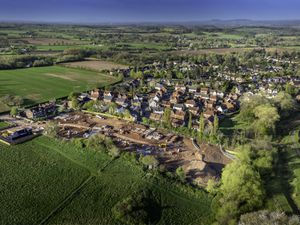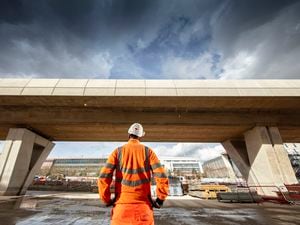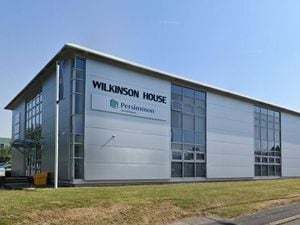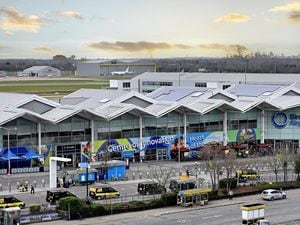Midlands sites under threat: Heritage at risk on our doorstep
[gallery] They have become familiar parts of the landscape to thousands of residents who pass them by every day. But many people may not realise that these historic buildings are among the country's most at risk sites.
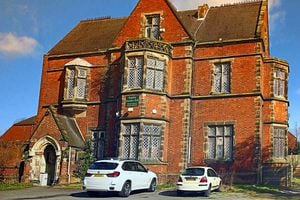
Heritage campaigners have drawn up a list of buildings that they believe could end up knocked down or falling into disrepair if action is not taken.
And while some are instantly recognisable, others are less obvious. But they all form part of the Black Country and Staffordshire's history, and experts say there is no reason to get rid of them.
The SAVE group, which is marking its 40th anniversary this year, is about to release its latest catalogue of at risk buildings.
And English Heritage recently compiled a list of sites that are vulnerable to making way for developments.
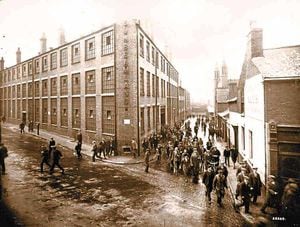
Historic buildings are also central to a range of new developments that have promised to retain their historic features.
The region's glassmaking heritage will be celebrated at a £5 million museum being built at the old Stuart Crystal factory in Wordsley.
Just the structure remains after it was hit by a series of arson attacks, but bosses are now waiting for £2.15m European funding to be granted before work can start on the plans, which have been on the table since 2010.
The first stage ahead of the construction of the museum has begun.
While they wait, Preparatory groundworks and an archaeological dig have now got under way on the site where the old White House Glass Cone once stood.
The museum, which will have a modern glass front, is to face the Red House Glass Cone. It's due to open in 2016, and will also pay homage to its past with a striking light sculpture representing the old White House Glass Cone.
The scheme will create 23 jobs and it is hoped the museum will attract more than 500,000 visitors per year.
It will showcase the borough's glass treasures and highlight the area's heritage through interactive displays.
And Wolverhampton's landmark Sunbeam factory will become 115 homes.
The development of the site, which has been derelict since 1997, is a boost for a key gateway into the city centre according to city council chiefs.
The plan, put forward by former Rugby League player Liam Wordley, will see 32 of the houses providing accommodation for people with learning disabilities.
The remaining properties would be made available for private rental.
Part of the building will be demolished and room made available for 37 parking spaces, a courtyard containing an outdoor games area, cycle parking and charging space for mobility scooters.
The Grade II-listed Lightwoods House in Bearwood, which dates from 1791, will be brought back into public use for community meetings, training and functions.
The ground floor will provide public toilets, a tea room and exhibition space.
Restoring
The upper floors will have rooms for the community, conferencing, weddings and commercial office space.
Other work to the Lightwoods House will include restoring the drinking fountains, Shakespeare Garden, walls and railings and a pond.
The park aims to provide an attractive gateway into Sandwell being located off the busy Hagley Road Junction.
Smethwick Toll House has been a fixture on the High Street since 1820 but it unlikely that the majority of shoppers or commuters pay it much attention each day.
But it is among five sites in the West Midlands chosen by SAVE in its latest investigations.
The toll house and associated coach house is Grade II-listed and served the Birmingham, Dudley and Wolverhampton turnpike which was formed in 1760.
At first floor level in the middle bay is a blind recess with a pointed head, probably for a toll board.
According to the listing entry, it was known as The Blue Gates from which a nearby inn took its name.
The toll house and former coach house were most recently let as an art gallery, but have now been vacant for a number of years.
It is on a busy main road between Oldbury and Birmingham and Smethwick Rolfe Street Train Station, and is currently available for let for commercial use, though agents have warned it needs plenty of renovation.
Meanwhile Langley Maltings is steeped in the history of the Black Country's brewing industry.
Originally dating from 1870, but substantially rebuilt in 1898, the maltings are a well known landmark in this part of Sandwell.
The site was built for the nearby Showell's Crosswell Brewery, with the 1898 buildings designed by Arthur Kinder & Son, notable brewery architects.
Although the brewery changed hands several times, remarkably the maltings were still in use as late as 2006 and it was one of the last to use the traditional floor malting process.
An arson attack in 2009 caused considerable damage to the buildings, but English Heritage concluded that 'despite some unstable masonry, repairing the building would be relatively straightforward'.
An application for demolition was submitted by the owner in 2012, but the council rejected the plans after an outcry from residents.
Businessmen Lehmber Singh and Harbhajan Singh Dhadday, who run D&S Enterprises, bought the property for £1 million in 2007.
Mr Dhadday said they were still hoping to submit a planning application to build housing.
"We will see what the demand is. We don't want the structure demolished, but the way it is going is very difficult," he said.
"We don't want to demolish it unless the worst comes to the worst. The amount of fires there is really bad, but we will try and retain what we can."
In Staffordshire, Heron Court has been singled out as an example of Tudor Gothic architecture.
The building, in Heron Street, Rugeley, was constructed in 1851 at the time that Rugeley was expanding from a market town to a coal mining centre.
It was used as a convent and more recently as the home of a billiard club.
Cannock Chase Council has invested £700,000 to preserve frontages in the town, with some being spent on Heron Court.
Cannock Chase Council's head of planning and regeneration Bob Phillips said: "It is hoped that the investment in Rugeley and the work taking place will encourage other building owners to invest in their own properties, resulting in more widespread improvements and encourage economic regeneration in the area."
Meanwhile English Heritage has named two well-known Dudley churches on its list of landmarks under threat. St Thomas and St Luke's Church in High Street, Dudley, known as Top Church, is a shock new addition to this year's Heritage at Risk register. St John's Church in Dudley is now also on the list.
A total of 195 sites across the Black Country, Staffordshire and North Worcestershire have now been identified as being at risk in the latest survey. Five new buildings in the area, all of them churches, have been added.

In the 1960s, beautiful and historic buildings were torn down often without a second thought as planners got caught up in the first major rush of post-war development.
It is still happening today, but in recent decades there has been a noticeable change in attitude as people become more aware of the importance of preserving an area's heritage.
And there are now campaign groups formed specifically to fight for the future of these sites.
English Heritage regularly compiles a list of under threat buildings, and the SAVE group is releasing its latest catalogue on July 22.
SAVE leaders say they are mainly concerned with historic buildings at risk through neglect and decay.
The sites range from those that are virtually on the point of collapse to others that are 'just a bit ragged around the edges', and from vacant to inhabited buildings.
They also do not have to be listed, as long as they are seen to be an important part of the area or have historical significance.
SAVE says there are many reasons why so many buildings are at risk. Buildings can become empty when firms go out of business or technology becomes outdated.
Textile mills, churches, schools, hospitals, farm buildings, railway stations or Ministry of Defence sites, such as the Royal Aircraft Establishment in Farnborough, are just a few examples. The Farnborough site was shut down in 1994.
Less obvious problems are faced by the traditional high street shops, many of whose upper floors are unused and poorly maintained, putting the whole property at risk. But standing empty need not be the death knell for a building – in the majority of cases a new use can be found.
Many buildings, however, particularly agricultural or industrial, have been redundant for years.
Without regular maintenance their condition often deteriorates before a new use is identified, leading in some cases to their demolition – a stage that SAVE says historic buildings should not be allowed to reach.
There are also many buildings whose future is jeopardised by owners who, for a variety of reasons ranging from neglect to lack of funds, have allowed their buildings to fall into disrepair.
One of the biggest problems is that often the owners refuse to repair or sell the building at a reasonable price. These problems can be overcome, but they lengthen the time before the building is repaired thus raising the amount of repair required.
Another problem is unclear ownership. It has been estimated that a third of Britain's 18 million or so properties are still either unregistered or the title is unclear.
However, nine buildings have been removed after finding a more secure future. St Thomas and St Luke's Church is considered to be Dudley's premier church and is used for civic functions. The Grade II listed building, built between 1815 and 1818, is said to be in 'poor' condition.
Ten years ago £528,000 was spent restoring its spire.
Meanwhile, St John's Church in St John Street closed in 2002 for safety reasons after structural problems were discovered.
Since then, the congregation has met at the church hall.
Worcester Diocese, which owns the building, initially said it may be declared redundant and demolished. However, the St John's Church Preservation Group was formed in 2007 to save the building, and it was granted Grade II-listed status in 2009.
William Perry, better known as The Tipton Slasher, who was England's bare-knuckle boxing champion from 1850 to 1857, and Marion Richardson, a well-known author of children's handwriting books, are among those buried in the churchyard. Deb Brownlee, group chairman, said she was pleased the church had been included as it highlighted the importance of getting it restored.
However, she said the group was in talks with Worcester Diocese about taking over the lease of the church with a view to restoring it.
"I would hope that by this time next year we will have taken over the lease and will have begun the restoration of the church, so it can come off the list," she said.
Other entries on the register include the Church of St Michael at Witley Court, near Stourport-on-Severn, and St James's Church in Hartlebury, near Kidderminster.
St Michael's, based in the grounds of the Earl of Dudley's former residence, is famous for its spectacular Italianate style guilded decorations and paintings by Antonio Bellucci.
While St James's Church in Quarry Bank, Hartlebury, was mostly built in the 19th century, although it has retained its 16th century tower.
And in Wolverhampton St Luke's Church in Upper Villiers Street is at severe risk as its condition is deteriorating rapidly, English Heritage says.
It is described as in 'very bad' condition and as being 'of immediate risk of further rapid deterioration or loss of fabric'.
Built by GT Robinson of Leamington in 1860, the church's huge, decorated spire is a local landmark in the Blakenhall area.
The problem of dry rot was addressed some years ago, but many other issues remain.
The city's Church of St Leonard, in Church Street, has leaking gutters that are damaging the stonework and causing water damage inside. It still has a number of original features from when it was built in 1825, but English Heritage says they could be lost if repairs are not carried out.
Birmingham city centre has plenty of historic buildings that have stood the test of time, but one that has an uncertain future is Unity House in the Southside district.
The locally listed site dates from 1900 and is the work of William Jenkins, who was a pub architect receiving commissions from Mitchells and Butlers brewery.
Originally a pub called the Rose and Crown, it later became offices for several trade unions.
But it has been in a parlous state for many years. Windows have been left open to the elements and two side ranges have been partially demolished.
Its current plight is the more striking considering its location at the heart of one of the city's theatre and nightlife districts which hums day and night. The National Trust's Back to Backs Museum is just one street away and tells the story of 19th and 20th century life in Birmingham. Campaigners say they hope the public will realise how important these buildings are.
Liz Fuller, SAVE's buildings at risk officer, said: "The catalogue aims to introduce buildings at risk to those with the determination and imagination necessary to save them.
"We also hope to inspire the many individuals and groups around the country who campaign to save buildings by highlighting those which make the places they are in special. A great deal more is needed to save a building at risk than just falling in love with it, but it is a good place to start."
Mike Fox, SAVE caseworker, added: "With 100 new entries covering so many different building types, Falling In Love should offer something for everyone interested in architectural heritage and buildings at risk.
We hope our readers will fall in love with these new entries and take up the challenge of restoring them to former glories."


